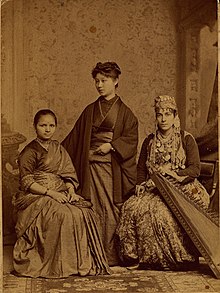This year for Women’s History Month, we want to highlight women who have impacted the daily lives of Pennsylvanians and improved our world.
Keiko Okami, the first Japanese woman to obtain a medical degree from a Western university, paved the way for future generations. As we celebrate Women’s History Month, it’s important to remember the incredible accomplishments of women like her.
Keiko Okami was born as Keiko Nishida on September 11, 1859, in Tokyo, Japan. During her childhood, Japan was going through a period of intense change, transitioning from feudalism to a modern, industrialized society. As a young girl, Keiko was knowledgeable and deeply interested in education. She attended a school for girls run by the American missionary Sarah Prudden, where she learned English.
In 1878, Keiko graduated from the Sakurai Girls’ School and became an English teacher. During this time, she met her future husband, an art teacher named Frank Okami. Frank was also deeply interested in Japanese culture, and they fell in love. In 1880, they got married and moved to the United States.
While living in the U.S., Keiko pursued her dream of becoming a doctor. She applied to the Women’s Medical College of Pennsylvania, which would later merge with other schools to become a part of Drexel University. She was accepted, partly thanks to financial aid from the Women’s Foreign Missionary Society of the Presbyterian Church. Keiko studied hard and excelled in her classes, eventually graduating with a medical degree and becoming one of the first Japanese women to obtain a degree in Western medicine in 1889.
After graduation, Keiko moved back to Japan, where she became the first Japanese woman to practice Western medicine. She opened a clinic in Tokyo and focused on treating women and children. Her clinic became extremely popular, and she was widely respected for her medical expertise and dedication to her patients.
Throughout her career, Keiko faced many challenges as a woman in a male-dominated field. She had to fight against societal expectations that women should not work outside the home, let alone become doctors. But she persevered, and her example inspired many other women to pursue careers in medicine.
Keiko Okami passed away on September 2, 1941. Her legacy, however, lives on. She was a trailblazer who paved the way for future generations of women to pursue their dreams and break down barriers in male-dominated fields.
In honor of Women’s History Month, remember Keiko Okami and the countless other women who have made significant contributions to society. Let us celebrate their achievements and continue to fight for gender equality and women’s rights.

Photograph of Anandibai Joshee (left) from India, Kei Okami (center) from Japan, and Sabat M. Islambouli (right) from Ottoman Syria, students from the Woman’s Medical College of Pennsylvania. All three were the first woman from their respective countries to obtain a degree in Western medicine from a Western university.
Women’s Medical College of Pennsylvania
Keiko Okami was one of many trailblazers to graduate from the Women’s Medical College of Pennsylvania. Founded in 1850, the school maintained a long history of notable women who have made an indelible mark on the medical profession:
- Caroline Still Anderson (class of 1878), one of the first African American female physicians
- Anna Broomall (class of 1871), professor of obstetrics and founder of the first outpatient maternity and prenatal care clinic in the United States
- Susan Hayhurst (class of 1857) was the first woman to receive a pharmacy degree in the United States
- Agnes Kemp (class of 1879) was the first woman to practice medicine in Dauphin County, Pennsylvania
- Susan La Flesche Picotte (class of 1889), the first Native American female physician
- Mildred Mitchell-Bateman (class of 1946) was the first African American woman to hold an office in the American Psychiatric Association as vice president. Founded the Marshall University Department of Psychiatry and namesake of Mildred Mitchell-Bateman Hospital, West Virginia’s state psychiatric hospital.
Women’s History Month
Women’s History Month was established in 1981 as a national celebration, with Congress passing Pub. L. 97-28 authorizing the President to designate the week beginning March 7, 1982, as “Women’s History Week.” Congress continued to pass joint resolutions over the next five years, designating a week in March as “Women’s History Week.” In 1987, Congress passed Pub. L. 100-9 after being petitioned by the National Women’s History Project, officially designating March 1987 as “Women’s History Month.” From 1988 to 1994, Congress passed additional resolutions requesting and authorizing the President to declare March of each year as Women’s History Month. Since 1995, each year, Presidents have issued proclamations recognizing and celebrating the contributions women have made to the United States and highlighting the specific achievements women have made in various fields throughout American history.
Learn more at WomensHistoryMonth.gov.
